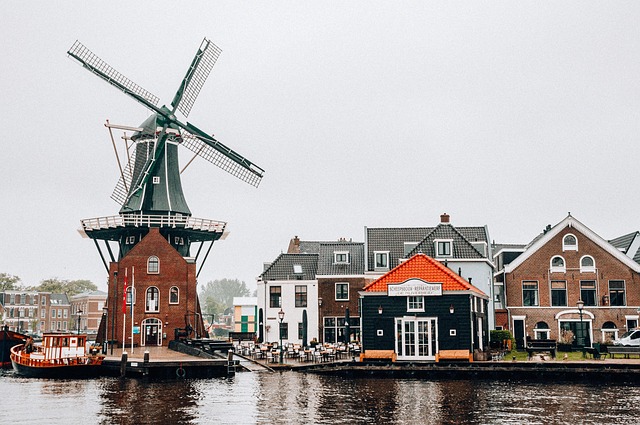Springfield, Oregon's founding (1847) was driven by visionaries seeking opportunities along the Willamette River, offering rich agricultural lands and vital trade routes. The town flourished with a booming logging industry leveraging its surrounding forests, which was catalyzed by railroad expansion in the late 19th century. This period sparked significant economic growth, population surge, and cultural evolution, transforming Springfield into a bustling center with diverse historical landmarks reflecting its logging roots to vibrant community status today. Key events like the railroad's arrival serve as game-changers, shaping Springfield's unique identity and cementing its place in Oregon history.
“Uncover the captivating journey of Springfield, Oregon’s transformation from a humble settlement to a thriving pioneer town. Delve into the early beginnings, where courageous settlers forged a path amidst the lush forests. Discover how the logging industry ascended, becoming a cornerstone of Springfield’s identity and driving its economic prowess. Witness the groundbreaking railroad expansion that connected Springfield globally, catalyzing unprecedented population growth and cultural evolution. Explore the historical landmarks that stand as testaments to this remarkable odyssey.”
- Springfield's Early Beginnings: From Settlement to Pioneer Town
- The Rise of Logging: An Industry That Shaped Springfield's Destiny
- Railroad Revolution: Connecting Springfield to the World
- Springfield Transforms: Historical Landmarks and Cultural Growth
Springfield's Early Beginnings: From Settlement to Pioneer Town

Springfield’s story begins with a small group of visionaries who sought new opportunities in the untamed wilderness of Oregon. Established in 1847, this town was initially a settlement driven by its location along the crucial Willamette River, offering rich agricultural lands and easy access to vital trade routes. The early settlers were primarily drawn by the promise of fertile soil for farming and the abundant natural resources, setting the foundation for Springfield’s future as a thriving logging industry hub.
As time progressed, Springfield’s transformation into a pioneer town was accelerated by significant infrastructure developments. The arrival of the railroad in the late 19th century sparked economic growth, connecting Springfield to broader networks and facilitating the transportation of goods and people. This expansion led to a surge in population, transforming the town into a bustling center with a diverse cultural evolution. The historical landmarks that dot Springfield’s landscape today bear witness to this rich heritage, showcasing the resilience and ingenuity of its pioneers while highlighting the town’s significant role in Oregon’s history, from its logging industry roots to its eventual status as a vibrant community.
The Rise of Logging: An Industry That Shaped Springfield's Destiny

Springfield’s early years were marked by a significant rise in the logging industry, which played a pivotal role in shaping its destiny. As the town was founded during the late 1800s, the lush forests surrounding Springfield became a prime resource for timber. The industry boomed with the arrival of railroads, enabling efficient transportation of logs to market. This railroad expansion connected Springfield to larger urban centers, fueling its growth and attracting new settlers.
The logging industry’s impact on Springfield’s history is evident through its cultural evolution and population growth. As loggers and their families settled in, they contributed to the establishment of various historical landmarks and left an indelible mark on the town’s identity. Springfield’s transformation from a small logging community to a thriving urban center is a testament to the resilience and determination of its pioneers, all while being driven by the lucrative logging industry.
Railroad Revolution: Connecting Springfield to the World

The founding of Springfield, Oregon, was intrinsically linked to its strategic location and subsequent connection through the Railroad Revolution. As logging became a key industry in the region, the need for efficient transportation to process and ship timber accelerated the push for railroad expansion. Springfield’s historical landmarks, such as the old train station, stand as reminders of this pivotal era that transformed the town into a bustling hub.
The arrival of the railroad not only connected Springfield to the broader world but also sparked significant population growth and cultural evolution. It attracted diverse individuals who contributed to the city’s vibrant tapestry, transforming it from a small logging outpost into a thriving community. This period marked a game-changer in Springfield’s history, setting the stage for its future development and solidifying its place as a prominent Oregon town with a rich founding history.
Springfield Transforms: Historical Landmarks and Cultural Growth

Springfield’s transformation from a humble founding to a thriving community is marked by significant historical landmarks and a cultural evolution that reflects its diverse past. The town’s early days were shaped by the logging industry, which brought workers and settlers seeking economic opportunities in the lush forests of Oregon. As Springfield grew, it became a crucial stop along the railroad expansion, further boosting its development and population growth.
These milestones left indelible marks on the city’s landscape. Historical landmarks like the old train station and well-preserved logging museums tell tales of Springfield’s past, while its vibrant cultural scene reflects the diverse influences that have shaped it. The community’s pride in its founding history is evident in local festivals and events that celebrate Springfield’s unique identity, fostering a strong sense of belonging among its residents and attracting visitors interested in exploring this fascinating chapter of Oregon’s history.
